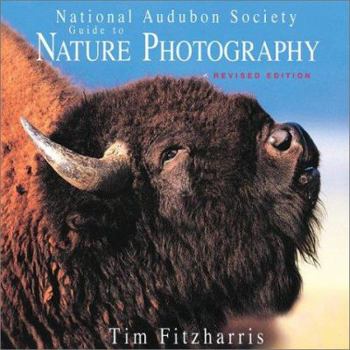National Audubon Guide to Nature Photography
Select Format
Select Condition 
Book Overview
Proven techniques for making award-winning photographs of the great outdoors. The National Audubon Society Guide to Nature Photography is an inspiring reference for both amateur and professionals who... This description may be from another edition of this product.
Format:Paperback
Language:English
ISBN:1552978087
ISBN13:9781552978085
Release Date:September 2003
Publisher:Firefly Books
Length:192 Pages
Weight:1.65 lbs.
Dimensions:0.6" x 8.6" x 8.5"
Customer Reviews
4 ratings
Read this before your next National Parks trip
Published by Thriftbooks.com User , 18 years ago
Ever wonder why those 11 a.m. or 2 p.m. summertime pics at the Grand Canyon look pretty crappy compared to what you see professionally? Well, Fitzharris has the easy answers, from time of day through time of year to use of filters. Fitzharris visits each park. Based on foliage and other considerations, he recommends the best photographic tims of year to visit. Then, in each park, he lists the best photographic hotspots with times of day to visit. Beyond that, he suggests how to plan a trip to each park to allow for morning and evening shooting along with midday hiking or other activities. The photos from each park perfectly illustrate the suggestions he supplies.
Great book with a noticable bias
Published by Thriftbooks.com User , 20 years ago
There is not much I can add to the previous reviews of this wonderful book. The photos are superb and there is a plethora of great information. My only problem is the author's obvious bias towards Canon products. It is fine to have a favourite camera, but not by providing misinformation about another brand. Long Canon lenses are not 75% shorter and two-thirds lighter than Nikon lenses. Check out the web sites and you will get the exact opposite story. A small point perhaps, but one that I had to make.
Advance & creative techniques, complement to John Shaw's
Published by Thriftbooks.com User , 20 years ago
Tim Fitzharris Guide to Nature Photography is a complement to John Shaw's Nature Photography Field Guide, which has been widely ( & correctly) accepted as a "textbook" in this subject, up to this time.That's why the first part of this book tends to be a bit boring. Much of the discussion about the equipment is overlap and has been explain thoroughly in Shaw's book. I think Shaw gives us the basics and fundamentals in nature photography (the know-how theory of exposure and metering unusual situations, the best equipment to chose and use, etc). However, you will be amazed by how much you don't know about nature photography in the next parts and chapters of the National Audubon Guide to Nature Photography.Tim Fitzharris furnish you with many advance and creative techniques to create more appealing, artistic and creative photos. For examples, he explains clearly and beautifully how to use motion effects (including wind) to photograph many nature objects, the right angle to maximize perspective, modifying natural light (including advance technique of using neutral density filters), impressionism nature photography, etc. What makes this book more helpful is Tim Fitzharris also caters into details in important points of his explanations. He explains (more comprehensively than John Shaw does) about the techniques to get close to wildlife and the power of using blinds, how to photograph birds in flight and even as far as the shutter speed for action-stopping (freeze hummingbird with wings, or body only, great blue heron in flight, snow goose in flight, etc!). He also provides reader with picturegraphs (of animal portrait, how to exactly position the neutral density filter in various situations, etc). These proven techniques and detail information is unquestionably very helpful in boosting our learning curve.To help us to be more productive, Tim Fitzharris gives hints to the characteristics of the photogenic sites and also the nature photography calendar (North America).The photos always correspond with the topic discussed and they are breathtakingly beautiful and artistic. It made me wondering, what kind of photos will be presented in the next page. Moreover, they also serve as a good example. Even I learn so much about composition by looking at those stunning photos. However, I find one part of this book has been published in Fitzharris column in Popular Photography. Be aware for you who regularly read his monthly column (I don't).Another weakness, this book seems not presented in methodical or lack of systematical method in teaching you about nature photography. Perhaps the author and publisher want to avoid the textbook impression; they want it to be more artistic (in fact it is the way I feel about this book). Where should I find the action-stopping speed? I can't find it in the chapter about wildlife... neither I can find a thorough explanation about using neutral density filter in The Right Equipment Part. It is scattered in the book, depending on
Includes a review of top locations for photographing nature
Published by Thriftbooks.com User , 20 years ago
Tim Fitzharris' GUIDE TO NATURE PHOTOGRAPHY appears in its revised edition to cover proven techniques for making award-winning photos. From buying and using the best professional equipment suitable for nature shots to insider tips on field procedures and fullproof methods for composition and filtering, this also includes a review of top locations for photographing nature. Add gorgeous color photos and you have a real winner.




